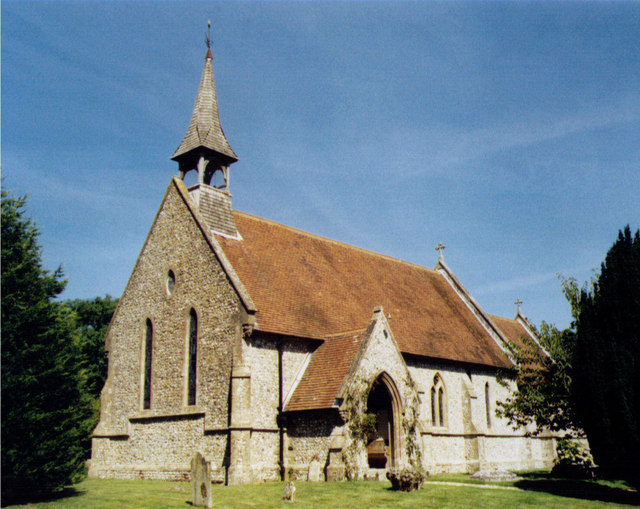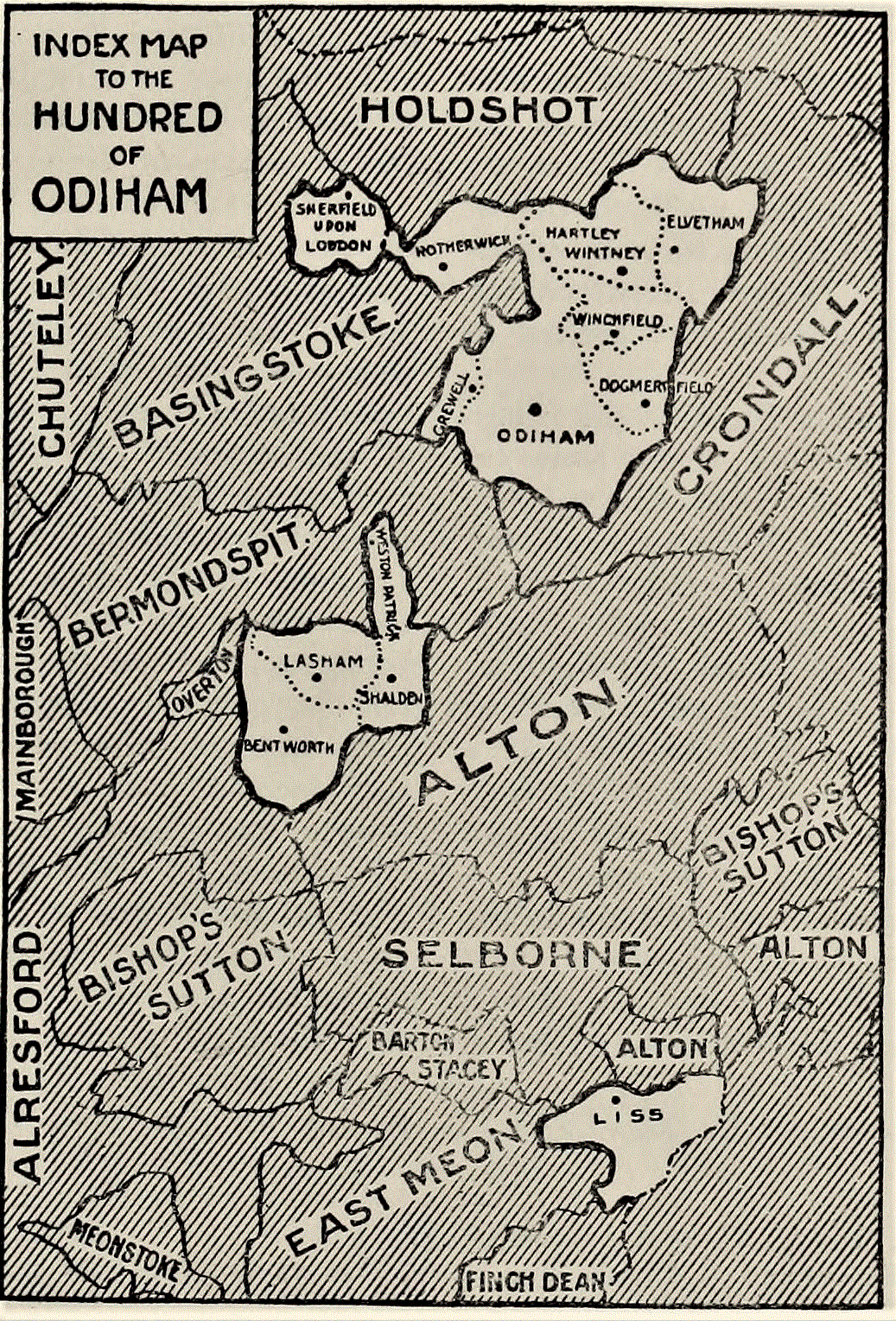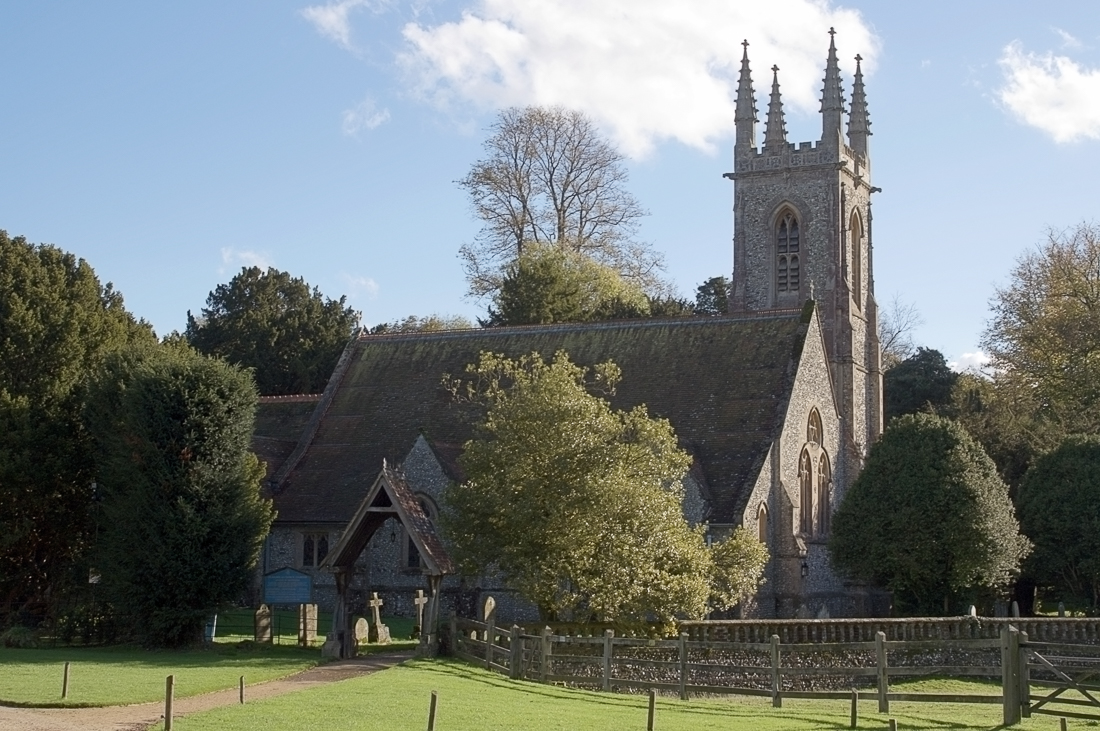|
Shalden
Shalden is a village and civil parish in the East Hampshire district of Hampshire, England. It is northwest of Alton and northeast of Bentworth, just off the A339 road. The parish covers an area of and has an average elevation of above sea level. The nearest railway station is Alton, southeast of the village. According to the 2011 census, it had a population of 435. Bronze Age and Roman remains have been found in the area. The manor of Shalden was recorded in the Domesday Survey of 1086, and was included in the Odiham Hundred. A Saxon church was in the village, but was destroyed and replaced with a newer church, which was constructed in 1863. The village contains twelve Grade II listed landmarks, including St Peter and St Paul's church, Shalden Lodge and Manor Farmhouse, a Grade II* listed building. History Prehistory to Roman The village name has been spelled in various ways, including Seldene (11th century), Schalden, Scaldeden, or Scaudedene (12th century), and Chald ... [...More Info...] [...Related Items...] OR: [Wikipedia] [Google] [Baidu] |
Shalden Sign
Shalden is a village and civil parish in the East Hampshire district of Hampshire, England. It is northwest of Alton and northeast of Bentworth, just off the A339 road. The parish covers an area of and has an average elevation of above sea level. The nearest railway station is Alton, southeast of the village. According to the 2011 census, it had a population of 435. Bronze Age and Roman remains have been found in the area. The manor of Shalden was recorded in the Domesday Survey of 1086, and was included in the Odiham Hundred. A Saxon church was in the village, but was destroyed and replaced with a newer church, which was constructed in 1863. The village contains twelve Grade II listed landmarks, including St Peter and St Paul's church, Shalden Lodge and Manor Farmhouse, a Grade II* listed building. History Prehistory to Roman The village name has been spelled in various ways, including Seldene (11th century), Schalden, Scaldeden, or Scaudedene (12th century), and Chalden ... [...More Info...] [...Related Items...] OR: [Wikipedia] [Google] [Baidu] |
Bentworth
Bentworth is a village and civil parish in the East Hampshire district of Hampshire, England. The nearest town is Alton, which lies about east of the village. The parish covers an area of and at its highest point is King's Hill, above sea level. According to the 2011 census, Bentworth had a population of 553. It lies on the edge of the East Hampshire Hangers. The village has a long history, as shown by the number and range of its heritage-listed buildings. Bronze Age and Roman remains have been found in the area and there is evidence of an Anglo-Saxon church in the village. The manor of Bentworth was not named in the Domesday Survey of 1086, but it was part of the Odiham Hundred. Land ownership of the village was passed by several English kings until the late Elizabethan era. During the Second World War, Bentworth Hall was requisitioned as an outstation for the Royal Navy and nearby Thedden Grange was used as a prisoner of war camp. The parish contains several manors ... [...More Info...] [...Related Items...] OR: [Wikipedia] [Google] [Baidu] |
Odiham Hundred
The Hundred of Odiham was a Hundred (a geographical sub-division of the area of a County) of Great Britain in the county of Hampshire. It contained the parishes of; Bentworth, Dogmersfield, Elvetham, Greywell, Hartley Wintney, Lasham, Liss, Odiham, Rotherwick, Shalden, Sherfield on Loddon, Weston Patrick, and Winchfield. At the time of the Domesday Survey the parishes contained in the modern hundred of Odiham were included in the two hundreds of Odiham and 'Hefedele'. The former comprised the villages of Lasham and Shalden and half a hide which had been taken from Preston Candover, and the latter included Odiham, Winchfield, Elvetham, Dogmersfield, and Bartley Heath (then "Berchelei") But for the manors of Bentworth, Greywell, Hartley Wintney, Liss Turney, Rotherwick, Sherfield on Loddon, and Weston Patrick, there are no entries in the Domesday Survey, but they were all probably included in the large manor of Odiham. The manor of Liss Abbas remained until 1831 in Meonstoke Hun ... [...More Info...] [...Related Items...] OR: [Wikipedia] [Google] [Baidu] |
East Hampshire
East Hampshire is a local government district in Hampshire, England. Its council is based in Petersfield. Other towns are Alton and Bordon. The district was originally to be known as the District Council of Petersfield. It comprised 42 seats and first met on 18 June 1973. For ten months it operated alongside the councils that it was formed to replace: the Alton and Petersfield urban districts along with Alton Rural District and Petersfield Rural District. On 8 October 1973, the new council changed its name to the current East Hampshire District Council (or EHDC as it is usually known). On 1 April 1974, the old councils were dissolved, leaving only EHDC. Sandy Hopkins was the first joint Chief Executive in Hampshire when she was appointed to head both EHDC and Havant Borough Council in October 2009. Councillors approved the business case put forward by the Chief Executive for a shared management team between the two authorities in June 2010. The new team took up its positi ... [...More Info...] [...Related Items...] OR: [Wikipedia] [Google] [Baidu] |
Sir Richard Young, 1st Baronet
Sir Richard Young, 1st Baronet (c. 1580–1651) was an English courtier and politician who sat in the House of Commons between 1605 and 1624. Young was born to a Welsh family and educated at Lincoln's Inn, in London. Circa 1603 he became secretary to Edward la Zouche, 11th Baron Zouche, the recently appointed Council of Wales and the Marches. With the creation of the new parliamentary seat of Bewdley in Worcestershire, Zouche nominated Young for the seat, which he held from 1605 until 1610. As an MP, he was active in defence of his employer's activities, but Zouche losing office meant that he had no sponsor to re-enter parliament; he did not stand for re-election in 1614.YOUNG, Richard (c.1580-1651), of Philip Lane, L ... [...More Info...] [...Related Items...] OR: [Wikipedia] [Google] [Baidu] |
John Wood (Bradford Manufacturer)
John Wood (1793–1871) was an English manufacturer in Bradford, a leading spinner of worsted. He is now remembered as a factory reformer associated with Richard Oastler, who campaigned for employment standards. Early life The son of John Wood senior (died 1832), a manufacturer in Bradford's Ivegate, he was apprenticed at age 15 to Richard Smith, a local worsted spinner. His father extended his premises, in which tortoiseshell was worked, with a steam-powered mill, where in 1815 John Wood junior went into business for himself as a spinner. Wood expanded and by 1828 employed 500 people. In 1830, a widower living at Horton Hall, he was visited by Richard Oastler, and persuaded him to look into "factory reform". Campaigner There had been a major strike by wool-combers and weavers in Bradford in 1825, a year of financial panic. Wood had been involved in mediation. It ended in defeat for attempts to unionise. Wood's outstanding concern was with issues raised by child labour. He ha ... [...More Info...] [...Related Items...] OR: [Wikipedia] [Google] [Baidu] |
Alton, Hampshire
Alton ( ) is a market town and civil parish in the East Hampshire district of Hampshire, England, near the source of the River Wey. It had a population of 17,816 at the 2011 census. Alton was recorded in the Domesday Survey of 1086 as ''Aoltone''. During the Saxon period Alton was known as ''Aweltun''. The Battle of Alton occurred in the town during the English Civil War. It also has connections with Sweet Fanny Adams and Jane Austen. History Early history The Alton Hoard of Iron Age coins and jewellery found in the vicinity of the town in 1996 is now in the British Museum. There is evidence of a Roman posting station at Neatham near Alton, probably called Vindomis, and a ford across the River Wey on the line of a Roman road that ran from Chichester to Silchester. An Anglo-Saxon settlement was established in the area and a 7th-century cemetery was discovered during building excavations. It contained grave goods including the ''Alton Buckle'' which is on display in the Curtis ... [...More Info...] [...Related Items...] OR: [Wikipedia] [Google] [Baidu] |
Imperial Gazetteer Of England And Wales
The ''Imperial Gazetteer of England and Wales'' is a substantial topographical dictionary first published between 1870 and 1872, edited by the Reverend John Marius Wilson. It contains a detailed description of England and Wales. Its six volumes have a brief article on each county, city, borough, civil parish, and diocese, describing their political and physical features and naming the principal people of each place. The publishers were A. Fullarton and Co., of London & Edinburgh. The work is a companion to Wilson's ''Imperial Gazetteer of Scotland'', published in parts between 1854 and 1857. The text of the Imperial Gazetteer is available online in two forms, as images you pay for on the Ancestry web site,Gazetteers at ukgenealogy.co.uk (accessed 4 November 2007) and as freely accessible searchable text on '' |
Thedden Grange
Thedden Grange is a privately owned country house and estate in the civil parish of Bentworth, on the outskirts of Alton, Hampshire, England. Since renovation in the mid-1970s the original house, outbuildings and land have been divided into seven separate properties plus additional flats. The house and grounds have been used as locations in a number of films and television programmes. The estate covers 40 acres of land, among which are 9 acres of ornamental garden. History Thedden has a long history going back to at least the 15th century, when it is recorded that William Estone paid rent for lands at the manor. In the 19th century Thedden Grange was owned by industrialist John Wood. During the Second World War the house was used as a prisoner of war A prisoner of war (POW) is a person who is held captive by a belligerent power during or immediately after an armed conflict. The earliest recorded usage of the phrase "prisoner of war" dates back to 1610. Belligere ... [...More Info...] [...Related Items...] OR: [Wikipedia] [Google] [Baidu] |
Henry III Of England
Henry III (1 October 1207 – 16 November 1272), also known as Henry of Winchester, was King of England, Lord of Ireland, and Duke of Aquitaine from 1216 until his death in 1272. The son of King John and Isabella of Angoulême, Henry assumed the throne when he was only nine in the middle of the First Barons' War. Cardinal Guala Bicchieri declared the war against the rebel barons to be a religious crusade and Henry's forces, led by William Marshal, defeated the rebels at the battles of Lincoln and Sandwich in 1217. Henry promised to abide by the Great Charter of 1225, a later version of the 1215 '' Magna Carta'', which limited royal power and protected the rights of the major barons. His early rule was dominated first by Hubert de Burgh and then Peter des Roches, who re-established royal authority after the war. In 1230, the King attempted to reconquer the provinces of France that had once belonged to his father, but the invasion was a debacle. A revolt led by William ... [...More Info...] [...Related Items...] OR: [Wikipedia] [Google] [Baidu] |
Chawton
Chawton is a village and civil parish in the East Hampshire district of Hampshire, England. The village lies within the South Downs National Park and is famous as the home of Jane Austen for the last eight years of her life. History Chawton's recorded history begins in the Domesday survey of 1086. The village held nineteen free residents, eight smallholders, six slaves (part of the sixty-seven slaves in the area from Alresford to the ridge parishes) and woodland with fifty pigs. In the 13th century, there was a royal manor house. The owner, John St John, served as deputy to Edward I in Scotland. Henry III visited the manor on over forty occasions. The descendants of John Knight, who built the present Chawton House at the time of the Armada (1588), added to it and modified the landscape in ways that reflect changes in politics, religion and taste. One of those descendants was Elizabeth Knight, whose progresses were marked by the ringing of church bells and whose two husbands both ... [...More Info...] [...Related Items...] OR: [Wikipedia] [Google] [Baidu] |
South East England
South East England is one of the nine official regions of England at the ITL 1 statistical regions of England, first level of International Territorial Level, ITL for Statistics, statistical purposes. It consists of the counties of england, counties of Buckinghamshire, East Sussex, Hampshire, the Isle of Wight, Kent, Oxfordshire, Berkshire, Surrey and West Sussex. Major towns and cities in the region include Brighton and Hove, Milton Keynes, Southampton, Portsmouth, Slough, Reading, Berkshire, Reading and Oxford. South East England is the third largest region of England, with an area of 19,096 km2 (7,373 sq mi), and is also the most populous with a total population of over eight and a half million (2011). The region contains seven legally city status in the United Kingdom, chartered cities: Brighton and Hove, Canterbury, Chichester, Oxford, Portsmouth, Southampton and Winchester. The region's close proximity to London and connections to several national motorways have le ... [...More Info...] [...Related Items...] OR: [Wikipedia] [Google] [Baidu] |







